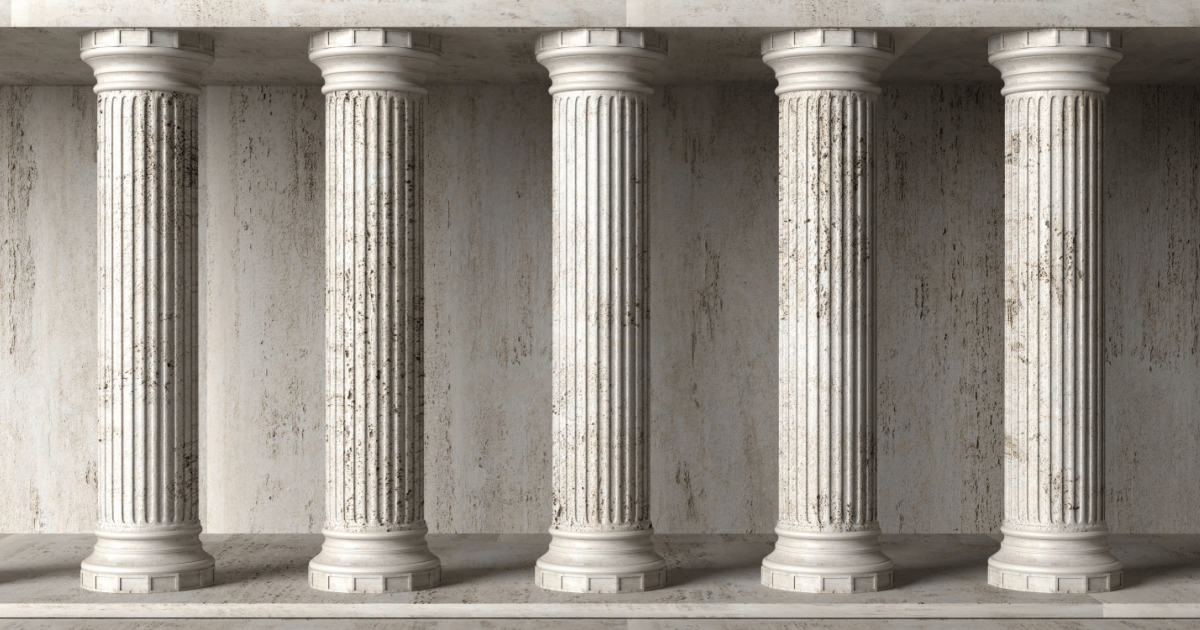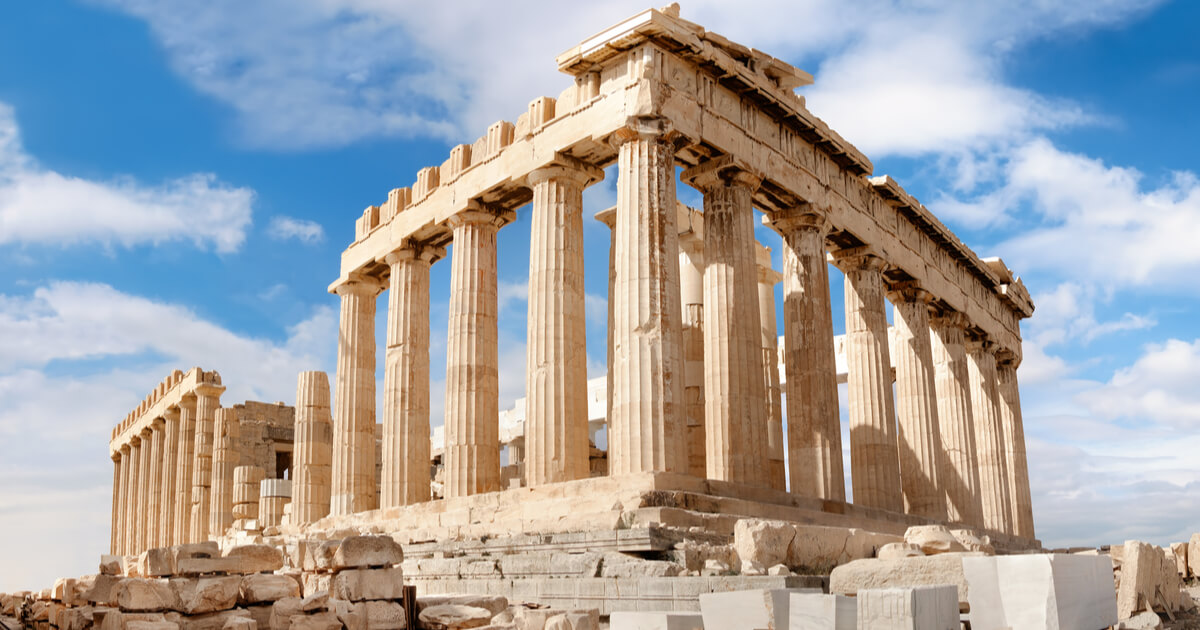September 27, 2023
Developing content pillars, for social media and beyond, ensures you have a clear and focused content strategy, a strong brand voice and messaging, and stand out from your competition.
This guide will walk through the benefits of content pillars, examples of different types of content pillars, and how to define and leverage your content pillars.
Chapters:
- What are social media content pillars?
- Why should you use content pillars?
- How to establish and implement content pillars
- Examples of content pillars in action
- Remember to create content pillars unique to each channel
Marketing and business leaders are after the same top objectives: to strengthen brand awareness, value, and loyalty.
Sprout Social’s 2023 State of Social Media report found that the top priority for the business leaders surveyed is to “build brand reputation and loyalty” in the current economic environment. Likewise, 87% of marketing leaders surveyed in Bazaarvoice’s How to Avoid Content Bias report said growing brand awareness and value are their top content goals.
With nearly 5 billion social media users worldwide, social is one of the most direct paths to these desired destinations. According to Sprout Social’s report, 96% of business leaders say it’s imperative to continue to invest in social media to be successful. So then, the question naturally becomes, how do you get from point A to point B? How can you use social media to boost brand awareness and affinity? It all comes down to content.
One of the great things about social media is also one of the trickiest if you’re a brand. Content creators are constantly finding new uses for social media and new ways to innovate. There’ are’s a variety of channels and features to promote your brand and products. The opportunities for success and experimentation are vast and so are the ways you can approach your social media content strategy.
With so many different choices available to brands, it can be easy to veer off course and go in the wrong direction. Content that misses the mark can lead to obscurity or a misalignment with your audience. But brands can keep their content on the right track and win their audience’s attention and loyalty with content pillars.
Embrace content pillars to drive your social media strategy forward with consistent and confident branding that sticks with your audience. Read on to learn how.
What are social media content pillars?
Content pillars are the themes unique to your brand that dictate each piece of content you create. Content pillars establish different categories to connect your content to, providing a clear roadmap to follow. These categories can be educational, entertaining, inspiring, or commercial, for example.
While brand pillars are different from content pillars, the former should be the engine that’s driving the latter. This means your content pillars should align with your brand’s values and identity with content that resonates with and matters to your audience.
How many content pillars should you have?
There’s no set number on how many content pillars you should have but between three and five is generally the sweet spot. You’ll want at least three so you can have enough to reflect your brand, but more than five or six and you start to lose your message.
Here’s some examples of what content pillars from different types of brands could include:
- Mission-driven content about environmental protection from a sustainable clothing brand
- Educational content about parenting and support from a baby products brand
- Cooking tutorials and recipe demos from a packaged foods brand
- Behind-the-scenes looks at employees’ personal interior styles from a home decor brand
- Funny dance trends or lip-syncing videos from an underwear and socks brand
- Shoppable content showcasing products used in creative ways from a beauty brand
- User-generated content created outdoors from a sporting goods brand
Why should you use content pillars?
Overall, content pillars allow you to create relevant content for your audience that strengthens your brand. Effective content pillars are tied to the challenges and motivations of your target audience. As a result, they help you increase brand awareness and loyalty by providing value to your audience. This establishes credibility because it shows you know what your audience wants.
Planning and crafting your content according to your designated themes and categories conveys consistent, strong messaging that your audience will associate with your brand. This strengthens brand recall while distinguishing your brand from competitors.
A bonus benefit is that content pillars keep the content flowing. They make the ideation process for planning content easier and more streamlined. If you’re ever struggling to come up with content to post for the next month, week, or day, your pillars will give you a starting point for new content to create or old content to repurpose.
They also ensure that you’re sharing a diverse and balanced mix of content. If you have four to six different categories or themes, you’ll have a rotation of different content types that are distinct from each other. And when you’re planning your content calendar, you can determine which categories you need to prioritize based on what needs more coverage at any given time.
How to establish and implement content pillars
Once you’ve decided to make content pillars part of your social media strategy, you need to define what they’ll be and how to put them into action. Use this step-by-step guide to make these determinations for your brand.
1. Define your content goals
First, you need to have a firm understanding of what you want your content to achieve. Then, you can design your content pillars to meet those specific goals. If you’re one of the many business and marketing leaders who want increased brand awareness, maybe that’s your main goal.
Other goals could be to generate more new customers, increase sales or average order value, or position yourself as an innovative industry leader.
Once you’ve determined your goal, you need to build your content pillars around it. For example, if your goal is to increase brand awareness, you should focus one of your content themes on whatever makes your brand niche. That could be sharing behind-the-scenes glimpses into your production process, stories and insights from company leaders, or unexpected ways to use your product. Brand-awareness content should show your brand’s personality and provide value to your audience by teaching and entertaining, not selling.
If you want to reach new audiences and customers, one of your pillars could be to collaborate with influencers and industry experts so they can introduce your brand to their audiences. If you want to increase sales, leverage social commerce by tagging your posts with products so your audience can make purchases directly from the content. Or if you want to be seen as an industry leader, demonstrate the impact of your brand on the environment, community, or individual customers by sharing real data and stories about results.
Whatever your goal is, connecting it directly to your content pillars will create a cohesive marketing plan your team can follow.
2. Identify what matters to your audience
Using the data and research from your target audience will be key factors in developing your content pillars. These are the people who are interacting with your brand, forming a connection with it, and ultimately purchasing your products, so reaching them with the right content is critical.
First, you need to know the channels where your audience is most active so you know where to post your content. Once you know where your audience is, determine the top content types for those particular channels. Then, you need to know your audience’s unique concerns and desires and how your brand addresses them. This will inform the topics and themes that they’re interested in.
For example, let’s say you’re a home decor and furniture brand. One of your customer segments includes first-time homeowners who are new to designing their own space and may not have a strong sense of interior style. They don’t really know where to start and they don’t have a huge budget. So one of your content themes could be about DIY tips and trends, and another could be about how to develop your unique home style and aesthetic.
Customer feedback is a goldmine for audience research. You can find what your customers use your products for, what they like about your brand, areas for improvement, and how your products make their lives easier, among other insights.
AI and machine-learning tools (like Bazaarvoice’s Insights & Reports) can automate this process to easily reveal customer sentiment and key themes found in customer reviews and question-and-answer threads.
3. Strike the right balance
A top advantage of leveraging content pillars is to ensure you’re addressing all the key reasons your audience would seek out your industry and your brand in particular. You want to make sure the different themes and categories for your content reflect those different intentions.
In practice, this could look like spacing out your promotional and commercial content on your content calendar so you have enough educational and entertainment-focused content in between. That way, you’re serving all the different types of content that matter to your audience but not fatiguing them with too much of the same category all at once.
Your audience wants to see a variety of content from different perspectives, not just the ones coming from your brand. That’s why it’s important to share user-generated content (UGC) in addition to the content your marketing team creates. Shoppers rely on UGC for brand and product research to make purchase decisions because it’s trustworthy content from other consumers like them. UGC, like visual posts on social media and product reviews, instills confidence in 53% of shoppers.
4. Analyze your social media performance
When developing your content pillars, analyzing your previous social media performance will provide valuable insights. Looking at analytics from the past months and years will show your best and worst-performing content. The content that your audience engages with the most will indicate which themes and topics are most relevant and important.
Social reporting tools give you detailed engagement metrics for individual pieces of content, such as the number of views and comments on TikTok videos or Instagram Reels’ engagement rate. You can even track the direct revenue earned from social posts to learn which ones drive transactions.
From there, you can identify the most successful formats and how different categories perform. And you can go even deeper into the individual pain points, use cases, and other related topics that resonate the most.
For example, let’s say in the past six months, your top-performing content included TikTok tutorials, funny and relatable lip-syncing Instagram Reels, and UGC tagged with products on Facebook. That tells you that your top categories are how-to, entertainment, and commercial content and the channels best suited for each.
Since the dawn of social media, it’s been an ever-changing and evolving digital landscape, and that hasn’t lost any momentum lately. Seemingly on a daily basis, we’re seeing more changes, from new platforms to content formats. This reality makes it even more important to keep up with your own content’s performance and advances in the space at large.
Examples of content pillars in action
To fully grasp how to implement a successful content pillar strategy, look at these examples of how other brands have done it. These brands in a variety of industries tied their content to the key themes that demonstrate their brand values and personality while putting their customers’ interests and needs at the center.
They produce a fresh, steady flow of content that keeps their social presence interesting and relevant.
Iconic London
Iconic London operates in the saturated beauty and makeup industry, but they still excel at implementing unique content. They’ve built content pillars that communicate their brand voice, form customer connections, and drive business results, creating a strong social media presence.
The brand’s social content demonstrates distinct categories that reflect their business and audience needs. Some of those categories include helpful makeup application tutorials, influencer content, UGC from their customers, and “shop the look” posts that leverage social commerce. This content is a mix of educational, problem-solving, inspirational, community-building, and promotional.
They encourage their customers to share their makeup looks on Instagram with the #ICONICLondon hashtag and tag the Iconic London account. They have tons of UGC to show for it because they have so many customers interacting with their brand and sharing it with their followers.
Midland Radio
Midland Radio is a consumer electronics brand whose content shows that they know their niche audience: people who are in remote outdoor locations — whether by choice or necessity.
Their social content covers the unique jobs, hobbies, and values that are relevant to their audience. These are people who use Midland Radio’s remote communication radios in areas and circumstances with poor cell phone service, like camping, emergencies, and outdoor activities.
On YouTube, Midland’s videos cover emergency prevention and preparation, how farmers and other outdoor workers can increase efficiency, and how to use their radios in different settings, like in RVs, outdoors, and in schools.
On Instagram, the full spectrum of Midland’s content is represented. Those key themes include meaningful stories about the impact on their customers, customer testimonials showing the value of Midland’s products, fun hobby content about sports and off-roading, and product tutorials. Midland also encourages posts by customers who are using their products, which they tag with the featured products to enable social shopping.
The company saw significant increases in sales on Instagram by leveraging social commerce.
Away
On social media, Away is so much more than a luggage brand. Away’s various content themes represent the different lifestyles of their customers. They reach far beyond the luggage used to pack clothes and personal items and encompass the reasons for travel, the process of traveling, travel destinations, and more. Away’s content pillars include:
- Travel guides to different cities
- Employees and customers demonstrating their favorite product features
- Funny content that leverages memes and travel puns
- Tips for navigating airports
- Content about the outdoor and indoor activities to explore while traveling
- Pet and animal-centered content because who doesn’t love seeing dogs, cats, and other cute creatures?
@away Booking a trip is always the answer
♬ original sound – away
Away also leverages TikTok with fun, stylish videos that show off their products and the people who use them. On Instagram, they use the Guides feature to create organized travel guides to a range of different global destinations. They also post a variety of striking, colorful images to their grid.
Remember to create content pillars unique to each channel
Your audience will likely have a significant presence on multiple channels. Your content should be tailored for each channel instead of just posting the same content on each. No two social channels are the same. They each have their own distinct formats, features, and popular content types.
However, you can repurpose one piece of content in different ways on different channels. For example, if you have a longer YouTube video, you can use one clip of it for TikTok, a still frame with audio for an Instagram post, or multiple clips for Instagram Stories.
Bazaarvoice has a variety of social media tools to bolster your content pillars strategy, from generating valuable UGC to repurpose and measuring performance to managing your social media content. Get started today and take your social media marketing to the next level.
Get started









